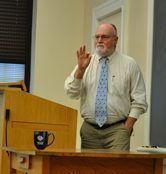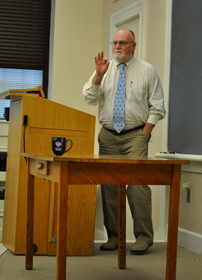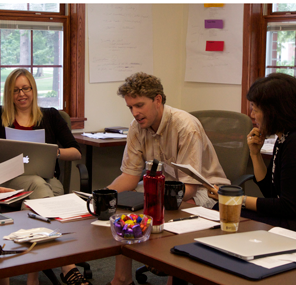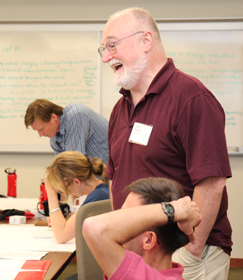When I started teaching I relied, like many others, on the examples of my own teachers. When I was an undergraduate, the teachers who moved me most were never straight lecturers. So, I tried to adapt their styles. The more I taught and especially the more I engaged with the literature about teaching and learning in the middle of my career, the more I developed an array of teaching strategies that depended upon student contributions to class sessions. As I continue to move in that direction, several things continue to surprise me.
- Listening becomes your most essential skill . . .,
- followed closely by the ability to keep your own mouth shut, at least some of the time (see Donald Finkel, Teaching with Your Mouth Shut [Portsmouth, NH: Boynton/Cook, 2000]).
- While it may seem like you are giving up your ability to set the agenda for class sessions, limiting the time you lecture actually switches the arena for agenda setting (see Stephen Brookfield and Stephen Preskill, Discussion as a Way of Teaching [San Francisco: Jossey-Bass, 2000, 2nd ed.).
- If anything, designing contexts for learning becomes more important when lectures aren’t the dominant mode of instruction (see L. Dee Fink, Designing Significant Learning Experiences [San Francisco: Jossey-Bass, 2003]).
- Assigning readings or other activities, posing questions to be considered, and various other activities can give shape and direction to the class session beforehand.
- When student contributions make up the bulk of a class session, making connections becomes one of your most important contributions.
- Ordering, juxtaposing, and otherwise relating student comments to each other is like making art, or at least sense, with found objects. It demands both discipline and creativity—and it can be fun.
- Mini lectures can still be an important part of a class session. They can summarize, make transitions, introduce new, related topics, and provide necessary background.
- “Coverage” begins to appear in a new light—where the mastery of facts takes a back seat to the demonstration of understanding through making statements, asking questions, venturing comparisons and other processes.
- Forms of evaluation or assessment need to be aligned with what actually goes on in the classroom. The work done in class sessions needs to be connected to the work done on higher stakes assignments.
- You never quite know what will happen . . .
- and that gives everyone an incentive to come to class, ready to work.
“Watch Gene’s decidedly untechnological TEDx talk on Millennialism”
Editor’s Note: Join us every Tuesday and Friday over the next two months as we explore more ways that we can achieve our teaching goals more effectively when lecturing less.
About Eugene V. Gallagher
Eugene V. Gallagher, Rosemary Park Professor of Religious Studies, Connecticut College. Gene has been at Connecticut College since the early Bronze Age and has taught courses on scripture, Western religious traditions from antiquity to the present, new religious movements and theories of religion. He lives in Mystic, CT with his wife, Jennifer, a health care executive and two Havanese, Javier and Lucy, who are sources of endless amusement. His daughter Maggie, a college junior, now views home as her country place. Outside of the classroom, his greatest privilege and most rewarding experience has been working with the Wabash Center in a number of capacities, including serving as Associate Editor of Teaching Theology and Religion. He has written numerous articles on ancient Mediterranean religions and on new religious movements in the U. S. He has published four books, including Why Waco? Cults and the Battle for Religious Freedom in America (with James D. Tabor) and has just finished the manuscript for New Bibles: Reading and Writing Scripture in New Religious Movements. When not working, he likes to be on, in, or under the water.



